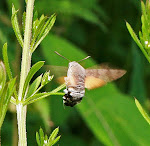A colony of Small Pearl-bordered Fritillaries was found on very boggy, acidic ground near Haverthwaite where the butterflies were frequently nectaring on bog-bean (Menyanthes trifoliata). This butterfly is usually found in open woodland and scrub, often over limestone, where its food-plant, various species of violet, commonly grow. Therefore, this unusual site was in strong contrast to its normal one. Small Pearl-bordered Fritillaries are much commoner than the close related, scarce, and now threatened Pearl-bordered Fritillary which flies earlier from May onwards, although their flight periods do overlap.
.jpg)
[Small Pearl-bordered Fritillary: upper side. Very similar to the Pearl-bordered Fritillary, below]
.jpg)
.jpg)
[Small Pearl-bordered Fritillary: underside. The additional silver spots, the dark chevrons, and the large central spot, all on the hind wing (see notes below) can be clearly seen]
Viewed from above the two species are very difficult to separate even when at rest but if the undersides of their hind wings are examined the differences become apparent. In the Small Pearl-bordered Fritillary, there are several additional central silver spots as well as the seven on the wing margin (there are only two bright central spots on the Pearl-bordered), the outer spots are outlined with dark chevrons and the adjacent line of dark spots is bold (this is not so in Pearl-bordered), and also there is a large black-margined central spot in the Small Pearl-bordered but this is almost insignificant in the other species. Compared with the male Small Pearl-bordered Fritillary, the female has more rounded wings, a broader body, and is more heavily marked.
See below for the Pearl-bordered Fritillary's upper- and under-sides as photographed at Gait Barrows recently.
.jpg)
[Pearl-bordered Fritillary, upper-side. Very similar to that of the Small Pearl-bordered Fritillary]
.jpg)
[Pearl-bordered Fritillary, showing its differently marked under-side]
.jpg)






As you have found, this species should always be looked out for on Cumbrian bogs in the lowlands or valley mires in the uplands, as well as in rush pastures and damp rushy gullies in the hills, if they still are unimproved and still have herbs flowering. SPB Fritillary uses marsh violet as well as the dog violets it eats in grasslands, and the marsh violet is extremely widespread in damp sites in the Lake District, as is the small pearl-bordered fritillary.
ReplyDelete